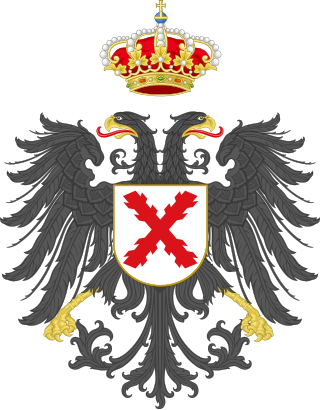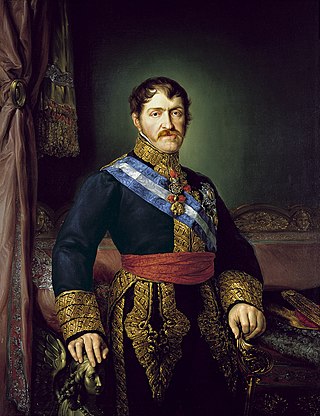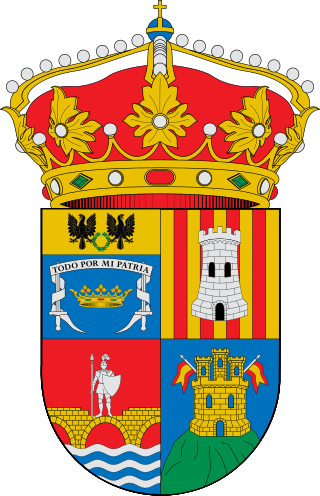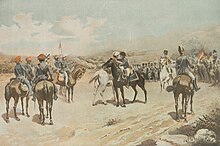
Carlism is a Traditionalist and Legitimist political movement in Spain aimed at establishing an alternative branch of the Bourbon dynasty, one descended from Don Carlos, Count of Molina (1788–1855), on the Spanish throne.

Baldomero Fernández-Espartero y Álvarez de Toro was a Spanish marshal and statesman. He served as the Regent of the Realm, three times as Prime Minister and briefly as President of the Congress of Deputies. Throughout his life, he was endowed with a long list of titles such as Prince of Vergara, Duke of la Victoria, Count of Luchana, Viscount of Banderas and was also styled as "the Peacemaker".

The First Carlist War was a civil war in Spain from 1833 to 1840, the first of three Carlist Wars. It was fought between two factions over the succession to the throne and the nature of the Spanish monarchy: the conservative and devolutionist supporters of the late king's brother, Carlos de Borbón, became known as Carlists (carlistas), while the progressive and centralist supporters of the regent, Maria Christina, acting for Isabella II of Spain, were called Liberals (liberales), cristinos or isabelinos. Aside from being a war of succession about the question who the rightful successor to King Ferdinand VII of Spain was, the Carlists' goal was the return to a traditional monarchy, while the Liberals sought to defend the constitutional monarchy.

Ramón Cabrera y Griñó, 1st Duke of Maestrazgo, 1st Marquis of Ter, 1st Count of Morella was a Carlist general of Catalonia. He renounced the combined and Spanish grandee title of 1st Duke of Maestrazgo with its annual stipend in favour of the less fortunate and kept instead both the Borbón recognised Carlist count and the subsequent Borbón marquis nobility titles.

DonCarlos María Isidro Benito de Borbón y Borbón-Parma was an Infante of Spain and the second surviving son of King Charles IV of Spain and his wife, Maria Luisa of Parma. He claimed the throne of Spain after the death of his older brother King Ferdinand VII in 1833. His claim was contested by liberal forces loyal to the dead king's infant daughter, resulting in the First Carlist War (1833–1840). Don Carlos had support from the Basque provinces and much of Catalonia, but lost the war. His heirs continued the traditionalist cause, fought two more Carlist wars and were active into the mid-20th century, but never gained the throne.

Spain in the 19th century was a country in turmoil. Occupied by Napoleon from 1808 to 1814, a massively destructive "liberation war" ensued. Following the Spanish Constitution of 1812, Spain was divided between the 1812 constitution's liberal principles and the absolutism personified by the rule of Ferdinand VII, who repealed the 1812 Constitution for the first time in 1814, only to be forced to swear over the constitution again in 1820 after a liberal pronunciamiento, giving way to the brief Trienio Liberal (1820–1823).

Bergara is a town and municipality located in the province of Gipuzkoa, in the autonomous community of Basque Country, in the north of Spain.

The Third Carlist War, which occurred from 1872 to 1876, was the last Carlist War in Spain. It is sometimes referred to as the "Second Carlist War", as the earlier "Second" War (1847–1849) was smaller in scale and relatively trivial in political consequence.

Rafael Maroto Yserns was a Spanish general, known both for his involvement on the Spanish side in the wars of independence in South America and on the Carlist side in the First Carlist War.

Vicente González Moreno was a Spanish general who supported the Carlists during the First Carlist War. He was appointed commander of Carlist forces after the death of Zumalacárregui.

The Battle of Ramales, a battle of the First Carlist War, occurred at Ramales in Cantabria on May 12, 1839. The successful Liberals were commanded by Baldomero Espartero, the Carlists by Rafael Maroto.

Chapelgorris, also called Peseteros, were a type of volunteer unit during the First Carlist War, raised at the beginning of the war in the province of Guipúzcoa. They fought against the Carlists.

Don Diego de León y Navarrete was a Spanish military figure. He was the son of Diego Antonio de León and Maria Teresa Navarrete y Valdivia. As a young man he joined the Spanish army as a cavalryman, and was promoted to the rank of captain at the age of 17.

Basilio Antonio García y Velasco, known as "Don Basilio de Logroño" in the newspapers of that time, was a Spanish soldier and Carlist military commander.
The end of Basque home rule or fueros in Spain was a process coming to a head in the period extending from the First Carlist War (1833-1840) to the aftermath of the Third Carlist War (1876-1878). It brought to an end the status of sovereignty coupled with allegiance to the Crown of Castile held by the different Basque territories for centuries. In the French Basque Country, home rule was abruptly suppressed during the French Revolution.

Prince of Vergara was a life title in the Peerage of Spain, granted in 1872 by Amadeo I to Baldomero Espartero, who was Regent of Spain from 1840 to 1843. The title makes reference to the Convention of Vergara, a symbolic embrace between Espartero and Rafael Maroto which put an end to the First Carlist War in 1839.

Espartero, or the monument to General Espartero, is an instance of public art in Madrid, Spain. A work by Pablo Gibert, it is dedicated to General Baldomero Espartero, "the Peacemaker".

The Royal Expedition, also known as Don Carlos' Expedition, was an 1837 operation in the late stages of the First Carlist War undertaken by the Carlist insurgents. Marking the highest point of Carlist control, it ended with a humiliating defeat and laid the groundwork for the end of the war in 1839.

Queen Isabella II of Spain was barely three years of age when her father, King Ferdinand VII, died on 29 September 1833. The years of her minority were marked first by the regency of her mother, Maria Christina of the Two Sicilies, and then under General Baldomero Espartero, covering almost the first ten years of her reign, until 23 July 1843, when Isabella was declared to be of age.

Ayacuchos is the nickname given by the opponents of the Spanish general Baldomero Espartero to the military men grouped around him and who formed a "camarilla" that had a notable influence during his regency (1840–1843) and with whom they shared the liberal-progressive political orientation. The name comes from the fact that all of them had participated in the Battle of Ayacucho (1824) that put an end to the Spanish American wars of independence, although curiously, Espartero himself did not participate in the battle of Ayacucho, as he was captured shortly after disembarking. By extension, the term was also used—although the expression "espadón" was preferred—to refer to the military men who played a leading role in the political life of the reign of Isabella II of Spain, of different political orientation.




















